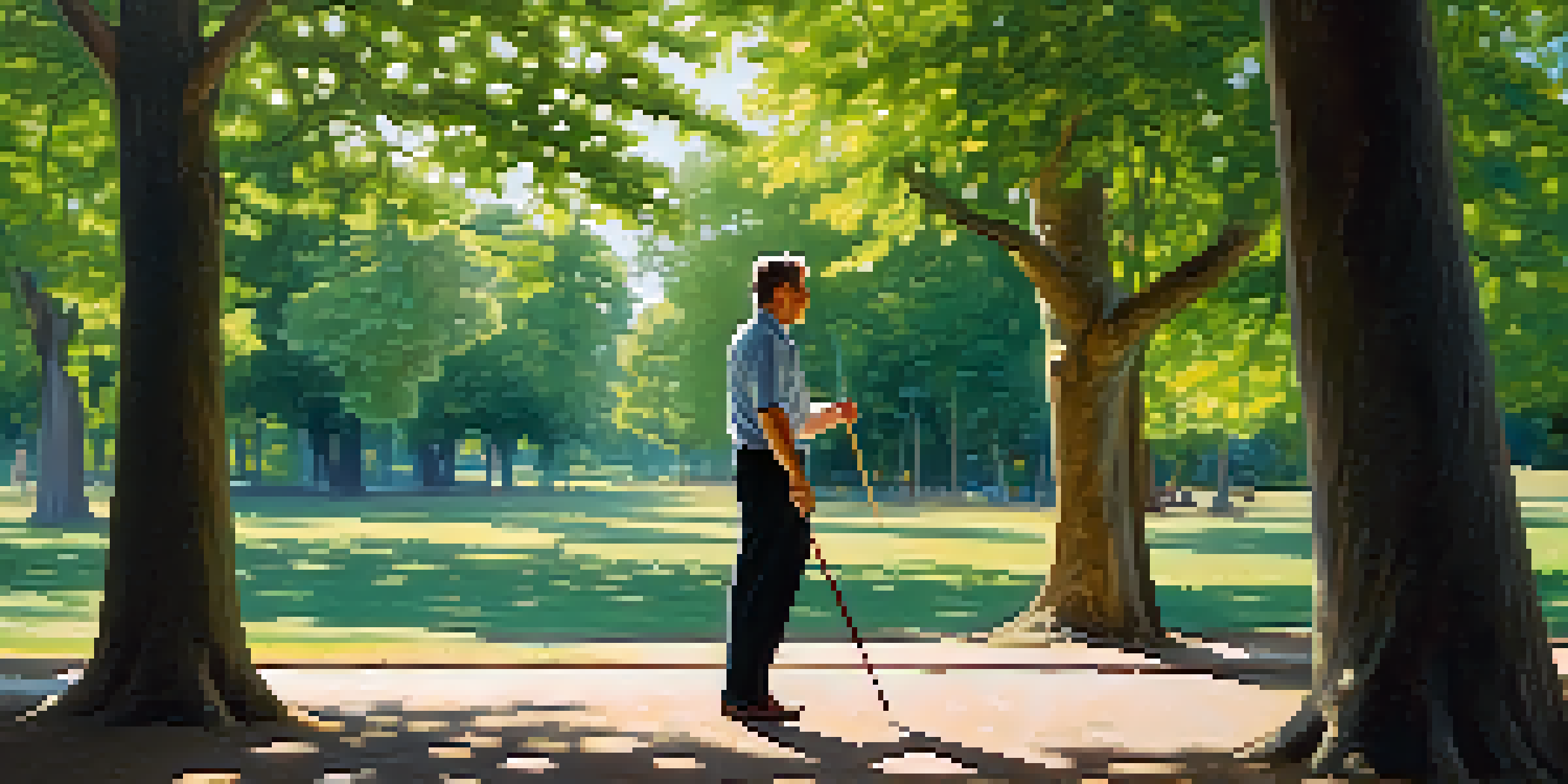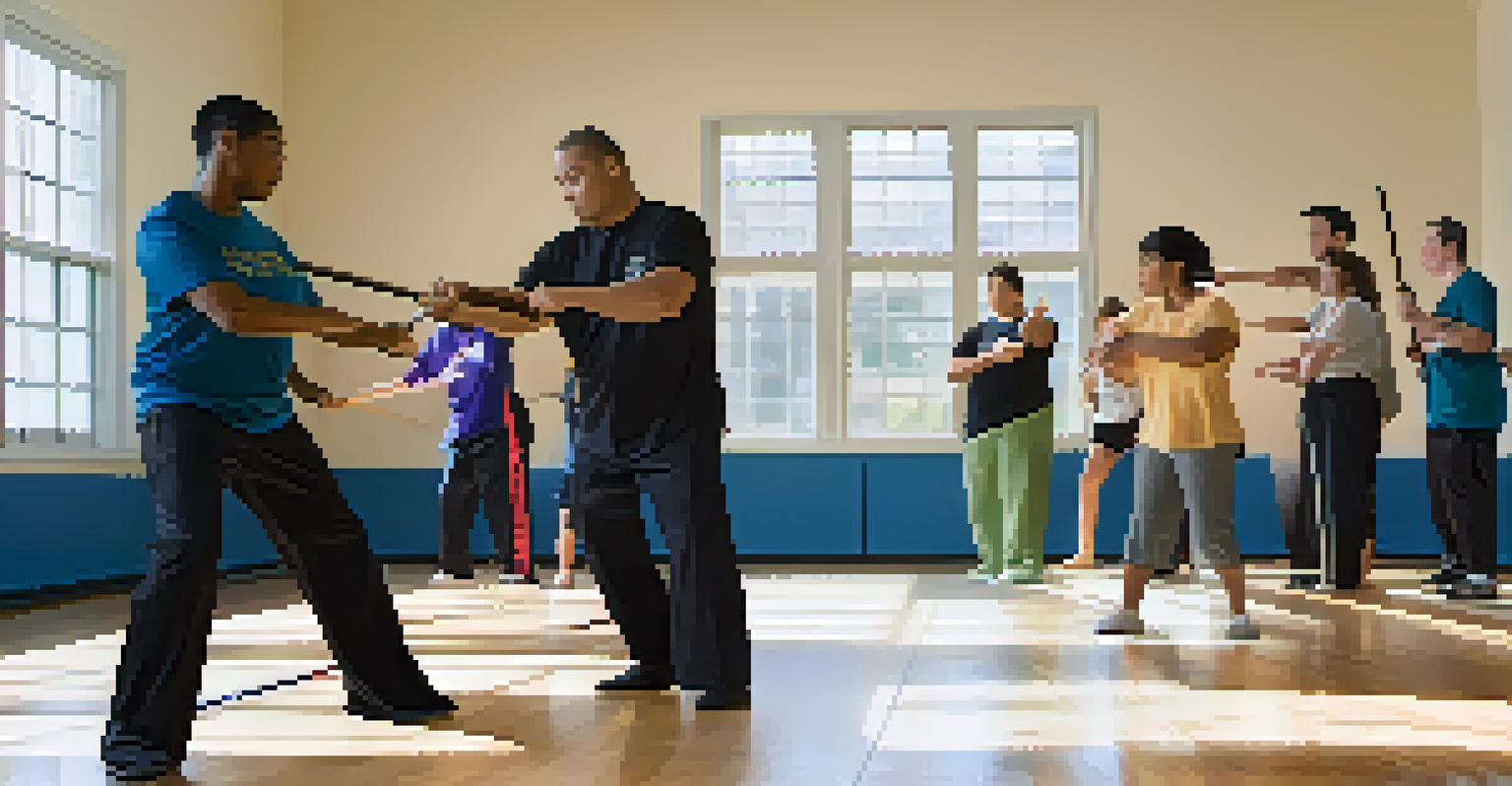Using a Cane for Self Defense: Techniques for the Disabled

Understanding the Cane as a Self-Defense Tool
A cane can be more than just a mobility aid; it can serve as a powerful self-defense tool. For many individuals with disabilities, a cane offers both support and a means of protection. By understanding its potential, users can feel more empowered in potentially threatening situations.
The best defense is a good offense.
Think of the cane as an extension of your own body. Just like a martial artist uses their arms and legs, you can learn to wield your cane with confidence. The key lies in embracing its utility, recognizing that it can deter aggressors and create distance when needed.
Moreover, using a cane for self-defense can be discreet. When walking in public, it appears as a simple walking aid, allowing you to maintain an element of surprise if the need arises. This dual function can make all the difference in a tense situation.
Basic Techniques for Cane Self-Defense
There are several basic techniques that can be effective for self-defense using a cane. One of the most straightforward moves is the jab, where you thrust the cane toward an attacker to create space. This not only acts as a barrier but can also stun an assailant long enough to escape.

Another useful technique is the swing or lateral strike. By swinging the cane from side to side, you can hit an opponent’s hands or arms, disarming them or causing them to back off. This motion can also be used to deflect incoming blows, adding another layer of protection.
Cane as a Self-Defense Tool
A cane can serve dual purposes, providing support and protection in threatening situations.
Lastly, remember to practice these techniques regularly. Building muscle memory will help you use your cane instinctively during high-stress situations. Just as with any skill, repetition is key to feeling confident and prepared.
Situational Awareness: Your First Line of Defense
While techniques are important, situational awareness is your first line of defense. Being aware of your surroundings can help you identify potential threats before they escalate. Take note of exits, people around you, and any unusual behavior.
Self-defense is not just a right but a responsibility.
For example, if you’re walking alone at night, choose well-lit paths and avoid areas that seem isolated. This proactive approach can reduce the likelihood of encountering danger. If you notice someone following you, trust your instincts and prepare to use your cane defensively.
Remember, the goal is to avoid confrontation when possible. By being aware and prepared, you can often steer clear of dangerous situations altogether. This mindset is an essential part of personal safety.
Integrating Cane Techniques into Daily Life
Integrating self-defense techniques into your daily routine can enhance your confidence. Practice using your cane as you walk, incorporating jabs and swings into your movements. This way, using your cane for self-defense becomes second nature.
Consider joining a self-defense class specifically designed for people with disabilities. Many instructors are willing to adapt their teachings based on individual needs, which can help you become more comfortable with your cane as a self-defense tool.
Situational Awareness Matters
Being aware of your surroundings is crucial for identifying potential threats and avoiding confrontations.
Additionally, practicing with a friend or family member can help reinforce your skills. Role-playing different scenarios allows you to think on your feet and improves your reaction time. This supportive environment can boost your confidence and readiness.
Legal Considerations in Self-Defense with a Cane
Understanding the legal implications of using a cane for self-defense is crucial. Laws regarding self-defense vary by location, so it’s important to familiarize yourself with local regulations. Generally, self-defense is justified when it is proportional to the threat faced.
For instance, if an attacker poses a physical threat, using your cane to defend yourself may be deemed acceptable. However, using excessive force could lead to legal repercussions. Always aim to de-escalate the situation before resorting to physical techniques.
Consulting with a legal expert can provide clarity on what is permissible in your area. Being informed will not only protect you legally but also give you peace of mind as you learn to use your cane for self-defense.
Mental Preparedness: Building Confidence
Mental preparedness is as important as physical techniques in self-defense. Cultivating a confident mindset can significantly impact your ability to react in a threatening situation. Visualization techniques, where you imagine yourself successfully defending against an attacker, can be particularly effective.
Positive affirmations can also help reinforce your self-worth and capability. Remind yourself that you have the right to protect yourself, and that using your cane is a valid and effective strategy. This mental conditioning can empower you to act decisively when the need arises.
Legal and Mental Preparedness
Understanding legal implications and cultivating a confident mindset are essential for effective self-defense.
Finally, consider engaging in mindfulness practices. Techniques like deep breathing can help calm your nerves and enhance your focus. A clear mind will enable you to assess situations more effectively and respond appropriately.
Resources for Learning Cane Self-Defense
There are numerous resources available for those interested in learning cane self-defense. Online videos and tutorials offer visual demonstrations that can be helpful for visual learners. Many instructors specialize in adaptive self-defense and can provide tailored lessons.
Local community centers or martial arts studios may also offer classes specifically designed for people with disabilities. These classes can create a supportive environment where individuals can learn at their own pace while connecting with others.

Don't forget to explore books and articles that discuss self-defense techniques with mobility aids. These materials can deepen your understanding and provide new strategies to incorporate into your practice.